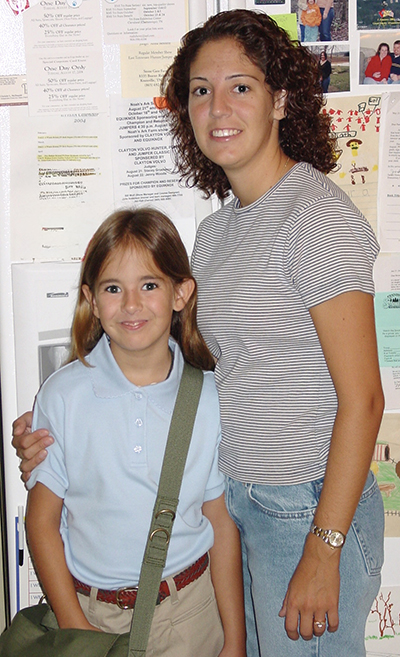Viox doesn’t let Type 1 diabetes slow her down
Diabetes Awareness Month feature: Part 1 of 3
Water Into Wine owner Candace Viox is always on the go and will not let diabetes Type 1 slow her down.
As a restaurateur, mother of two daughters, Rotary Club president and Shop Farragut Chairman, she never sits down.
“I don’t like to be a burden,” she reflected. So, Viox takes the necessary precautions.
“I wear a pump, and the pump on my body works with a Dexcom sensor,” she said. “So my Dexcom sensor will alert me that my sugar is going up — that my sugar is high — and my pump, made by Omnipod, talks to my Dexcom sensor and starts giving me insulin.”
Viox explained Omnipod is a type of fake pancreas.
“I need to be at a healthy blood sugar — between 80 and 120 — for me,” she said. “Some people are different.”
When Viox is alerted about her blood sugar, her Dexcom sensor will beep on her cell phone.
“I make the joke, I’m a robot,” she said. “When I’m speaking or when I’m in Rotary, I beep,” she said. “I just randomly beep. I’ll tell people, ‘it’s not my phone. I’m not being rude, but I have to carry my phone with me all the time because my phone talks to both of those (the Dexcom sensor and pump).
“If my sugar’s going high, it will alert me,” Viox said. “If my sugar’s going low, it will alert me — very loudly. My body doesn’t work so I’ve got to wear all these things that beep at me.”
While she makes a joke of it, she hates the disease.
“I hate being sick,” Viox said. “I hate having Type 1 diabetes.”
She explained Type 1 diabetes is when the body’s pancreas stops working while Type 2 generally affects people who eat more sugar or carbs than their body can create the insulin to combat.
“Generally, that’s why Type 2 diabetics tend to be struggling with their weight more than a Type 1,” Viox said. “Type 1 diabetics have high sugar for no reason.”
Usually the sugar is produced as in a fight-or-flight response. She explained if a person gets really anxious or is really stressed — the body will produce sugar to give energy to get away or get out of the situation.
“But, my body [produces sugar] all the time, for no reason, in my mind,” Viox said. “But, I don’t have the ability to make my own insulin because my pancreas is inoperative. It doesn’t work.
“So, I wear a pump,” she added.
Type 1 diabetes is an autoimmune disease.
Viox reflected she always has to be aware of what she eats, cannot travel by herself and always has to have insulin and a pen in case her technology fails.
“I have had these units come out of my body, and my pump I replace every three days, and that hurts,” Viox said. “My Dexcom, I have to put a new one in every 10 days, and that hurts … I am always at the mercy of this equipment.”
Additionally, she said she has a high-deductible health insurance plan and is out of pocket $6,000 every year before May.
“Type 1 diabetes sucks, and there’s no cure, and there’s nothing they can do,” Viox added. “The only thing we can do now is hope insulin prices come down, medical equipment pricing can come down, maybe possibly they find a cure or a fake pancreas.”
Still, Viox realized, “I am responsible for my quality of life … this is something I have to deal with every day.”
She did not find out she had Type 1 diabetes until after she was pregnant with her daughter while in her 20s.
“Type 1 diabetes tends to be caught when you are a child or teenager going through puberty and sometimes as a young adult,” Viox said. “But I’m adopted. Since I didn’t have any family history or family background, I was not aware I could be predisposed. The only thing I remember as a child (was) I never craved sweets.
“Later, when I was diagnosed, my doctor said that was my body’s way of protecting me,” she added. “Because, I’m a Type 1 diabetic, I tend to have high sugar because my pancreas stopped working, so I stopped making insulin.”
While Viox was pregnant with her daughter, “(the doctors) thought I had what’s called gestational diabetes. They thought my pregnancy was causing my diabetes,” she recalled.
“It wasn’t until later that they finally determined, no, my pancreas shut down, it’s not working. I have to start being on insulin,” Viox said.
“And, I was very sick,” she recalled. “When you have high sugar, you can get things like ketoacidosis. That’s where you have too much sugar in your body and causes you to start vomiting and passing out because your body’s trying to get rid of sugar.
“If it can’t get rid of the sugar, it starts shutting down all of your organs,” Viox said. “I had to go to UT emergency room a couple of times, where they had to literally flush my blood out and my body out to get that sugar out of my body.
“Type 1 diabetes is very frustrating and very difficult because it’s not just ‘Candace, just stop eating brownies’ … I don’t eat any of that junk,” she said. She noted her only vice is a glass of red wine, but “you’ll never see me drink a cocktail because of all the sugar.
“I have to be very aware all the time of what I am putting in my mouth and in my body with Type 1,” Viox said. “Type 2 diabetics, they are aware; they just like the brownies.”
So when someone brings her sweets, she said, “I will literally say to somebody, ‘Is it worth my insulin?’”
When dining out, she may take a bite of a dessert — “I can have a bite”— and “I will sometimes say, Yeah, that’s worth my insulin. Then I will grab my phone and I will go to my Omnipod app, I’ll click on it, and it will tell me what my sugar is.”




